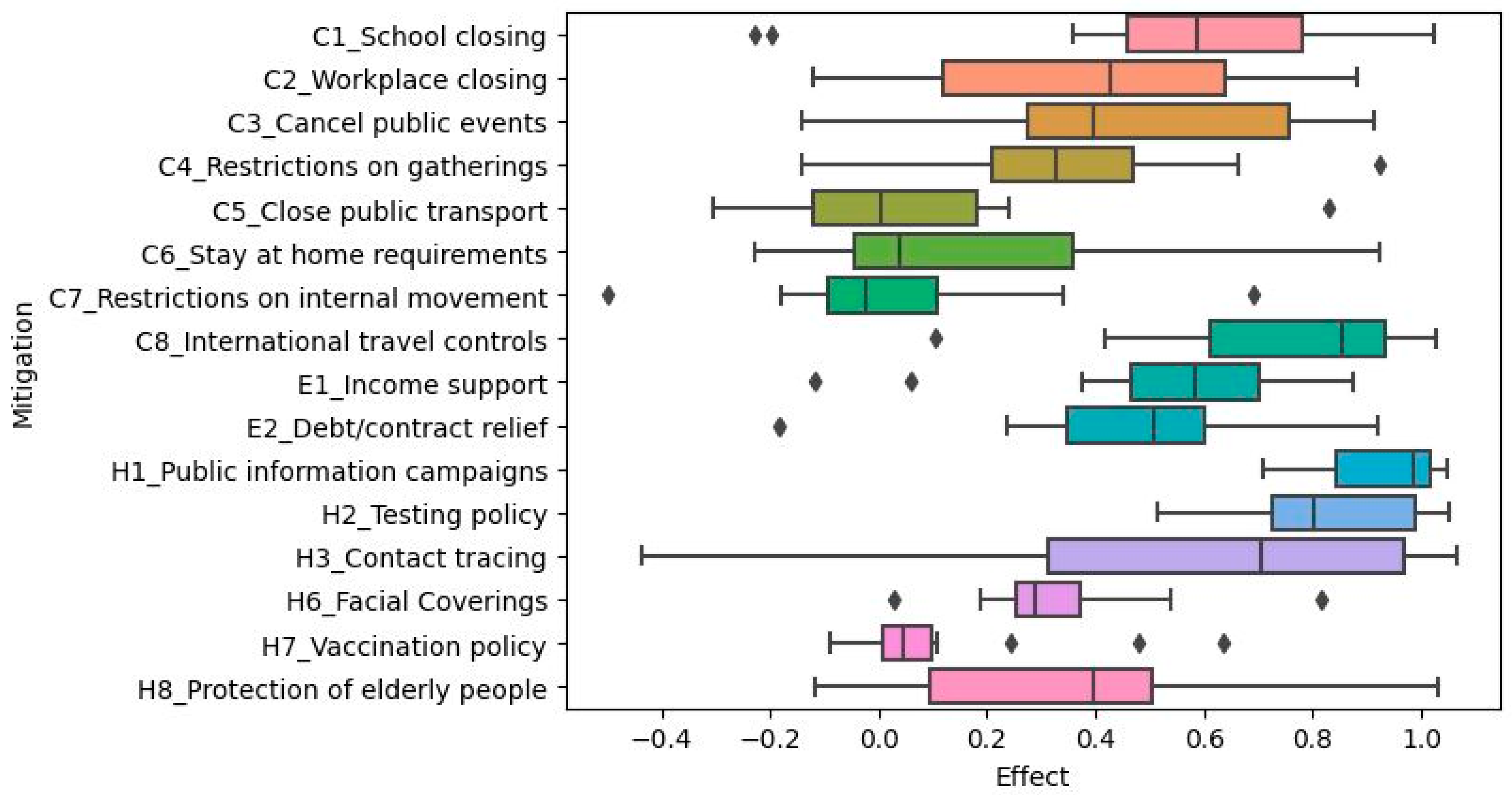Appendix A. Detailed Country Data
Bangladesh
First case: 23 February 2020
Restrictions on in-person learning: 16 March 2020 to 30 September
Restrictions to on-site work: 19 March 2020 to 10 August 2021
Public events canceled: 16 March 2020 to 16 July 2021; 23 July 2021 through 30 September 2021
Gatherings restricted: 19 March 2020 to 16 July 2021; 23 July 2021 through 30 September 2021
Public transport closed: 19 March 2020 to 16 July 2021; 23 July 2021 to 11 August 2021
Stay-at-home restrictions: 19 March 2020 to 15 July 2021; 23 July 2021 through 30 September 2021
Internal movement restricted: 19 March 2020 to 31 May 2020; 16 June 2020 to 24 May 2021; 31 May 2021 to 15 July 2021; 23 July 2021 to 6 August 2021
International travel restrictions: 22 January 2020 through 30 September 2021
Income support: 13 April 2020 to 14 May 2020
Debt/contract relief: 19 March 2020 to 31 May 2021; 26 August 2021 to 19 September 2021
Fiscal measures: 25 March 2020 (USD 595,000,000); 5 April 2020 (USD 8,564,857,500); 13 April 2020 (USD 91,000,000)
International support: 22 March 2020 (USD 1,500,000); 5 April 2020 (USD 500,000,000)
Public information campaigns: 21 January 2020 through 30 September 2021
COVID testing becomes available: 1 March 2020
Contact tracing begins: 24 January 2020
Emergency healthcare investment: 18 March 2020 (USD 29,550,000); 13 April 2020 (USD 100,320,307)
Investment in vaccines: none
Mask first recommended: 30 May 2020
Vaccine available to high-risk populations: 14 December 2020
Protection of elderly begins: 26 January 2020
Barbados
First case: 3 March 2020
Restrictions on in-person learning: 19 March 2020 through 30 September 2021
Restrictions to on-site work: 28 March 2020 through 30 September 2021
Public events canceled: 17 March 2020 through 30 September 2021
Gatherings restricted: 17 March 2020 to 25 July 2020; 29 October 2020 through 30 September 2021
Public transport closed: 8 April 2020 to 9 October 2020; 29 October 2020 to 6 June 2021; 11 September 2021 through 30 September 2021
Stay-at-home restrictions: 28 March 2020 to 21 August 2020; 31 December 2020 to 29 June 2021; 25 July 2021 through 30 September 2021
Internal movement restricted: 3 April 2020 to 21 August 2020; 26 April 2021 to 17 May 2021
International travel restrictions: 26 January 2020 through 30 September 2021
Income support: 1 April 2020 through 30 September 2021
Debt/contract relief: 1 April 2020 through 30 September 2021
Fiscal measures: 22 March 2020 (USD 10,000,000); 23 April 2020 (USD 1,000,000,000)
International support: 19 June 2020 (USD 15000)
Public information campaigns: 22 January 2020 through 30 September 2021
COVID testing becomes available: 26 January 2020
Contact tracing begins: 17 March 2020
Emergency healthcare investment: 29 October 2020 (USD 11,613,382)
Investment in vaccines: none
Mask first recommended: 11 April 2020
Vaccine available to high-risk populations: 16 February 2021
Protection of elderly begins: 17 March 2020
Belgium
First case: 21 January 2020
Restrictions on in-person learning: 14 March 2020 through 30 September 2021
Restrictions to on-site work: 13 March 2020 through 30 September 2021
Public events canceled: 10 March 2020 through 30 September 2021
Gatherings restricted: 18 March 2020 through 30 September 2021
Public transport closed: 3 April 2021 to 19 April 2021
Stay-at-home restrictions: 18 March 2020 to 8 June 2020; 29 July 2020 to 27 August 2020; 19 October 2020 to 30 July 2021
Internal movement restricted: 14 March 2020 to 8 June 2020; 28 July 2020 to 12 August 2020
International travel restrictions: 4 March 2020
Income support: 6 March 2020 through 30 September 2021
Debt/contract relief: 6 March 2020 through 30 September 2021
Fiscal measures: 19 March 2020 (USD 260,000,000); 20 March 2020 (USD 9,608,192,466); 22 April 2020 (USD 320,000,000); 3 June 2020 (USD 505,000,000); 6 June 2020 (USD 3,950,000,000); 12 June 2020 (USD 123,000,000); 9 July 2020 (USD 63,000,000); 22 July 2020 (USD 588,000); 9 Sepetember 2020 (USD 66,000,000); 24 September 2020 (USD 61,818,321.78); 21 January 2021 (USD 90,035,800)
International support: none
Public information campaigns: 28 January 2020 through 30 September 2021
COVID testing becomes available: 1 March 2020
Contact tracing begins: 25 February 2020
Emergency healthcare investment: 20 March 2020 (USD 1,076,350,000); 6 June 2020 (USD 565,000,000)
Investment in vaccines: 5 April 2020 (USD 5,427,500); 10 May 2020 (USD 22,000,000)
Mask first recommended: 24 April 2020
Vaccine available to high-risk populations: 28 December 2020
Protection of elderly begins: 11 March 2020
Bolivia
First case: 26 February 2020
Restrictions on in-person learning: 12 March 2020 through 30 September 2021
Restrictions to on-site work: 18 March 2020 to 5 January 2021; 13 July 2021 through 30 September 2021
Public events canceled: 12 March 2020 to 5 January 2021; 13 July 2021 through 30 September 2021
Gatherings restricted: 12 March 2020 to 1 December 2020; 13 July 2021 through 30 September 2021
Public transport closed: 16 March 2020 to 1 December 2020; 13 July 2021 through 30 September 2021
Stay-at-home restrictions: 17 March 2020 to 5 January 2021; 8 June 2021 to 28 September 2021
Internal movement restricted: 21 March 2020 to 5 January 2021; 13 July 2021 to 28 September 2021
International travel restrictions: 13 March 2020
Income support: 31 March 2020 to 21 September 2021
Debt/contract relief: 31 March 2020 to 1 July 2020; 1 January 2021 to 21 September 2021
Fiscal measures: 31 March 2020 (USD 169,813,247); 9 April 2020 (USD 187,000); 14 April 2020 (USD 215,500,000); 15 April 2020 (USD 201,000,000); 3 November 2020 (USD 584,000,000)
International support: none
Public information campaigns: 10 March 2020 through 30 September 2021
COVID testing becomes available: 7 April 2020
Contact tracing begins: 2 June 2020
Emergency healthcare investment: 28 April 2020 (USD 23,000,000); 22 July 2020 (USD 101,387,930); 26 July 2020 (USD 89,914); 5 January 2021 (USD 38,858,400); 30 May 2021 (USD 961,877.46); 4 June 2021 (USD 2,044,298.55); 5 June 2021 (USD 306,541.30)
Investment in vaccines: none
Mask first recommended: 1 May 2020
Vaccine available to high-risk populations: 29 January 2021
Protection of elderly begins: 1 January 2020
Denmark
First case: 13 February 2020
Restrictions on in-person learning: 13 March 2020 to 21 October 2020; 9 November 2020 through 30 September 2021
Restrictions to on-site work: 11 March 2020 through 30 September 2021
Public events canceled: 6 March 2020 to 10 September 2021
Gatherings restricted: 13 March 2020 to 1 September 2021
Public transport closed: 10 March 2020 to 10 October 2020
Stay-at-home restrictions: 3 March 2020 to 21 October 2020; 9 November 2020 to 19 November 2020; 23 November 2020 to 21 May 2021
Internal movement restricted: 13 March 2020 to 22 May 2020; 9 November 2020 to 19 November 2020
International travel restrictions: 3 March 2020
Income support: 9 March 2020 to 7 September 2021
Debt/contract relief: 18 April 2020 to 15 January 2021
Fiscal measures: 13 March 2020 (USD 1,112,519,936); 26 March 2020 (USD 42,066,226,711); 22 April 2020 (USD 2,175,900); 29 May 2020 (USD 3,219,069,854); 28 August 2020 (USD 15,993,841)
International support: 2 April 2020 (USD 94,575,000); 8 April 2020 (USD 1,091,655)
Public information campaigns: 27 February 2020 through 30 September 2021
COVID testing becomes available: 11 March 2020
Contact tracing begins: 27 February 2020
Emergency healthcare investment: 2 April 2020 (USD 94,575,000); 8 April 2020 (USD 1,142,352)
Investment in vaccines: 16 November 2020 (USD 3,000,000)
Mask first recommended: 9 July 2020
Vaccine available to high-risk populations: 27 December 2020
Protection of elderly begins: 17 March 2020
Estonia
First case: 13 February 2020
Restrictions on in-person learning: 16 March 2020 to 26 September 2021
Restrictions to on-site work: 27 March 2020 to 6 July 2021
Public events canceled: 12 March 2020 to 6 July 2021; 26 August 2021 through 30 September 2021
Gatherings restricted: 25 March 2020 through 30 September 2021
Public transport closed: none
Stay-at-home restrictions: 29 March 2020 to 18 May 2020; 11 March 2021 to 9 May 2021
Internal movement restricted: 14 March 2020 to 8 May 2020
International travel restrictions: 12 March 2020
Income support: 1 March 2020 to 1 July 2020; 8 March 2021 to 6 July 2021
Debt/contract relief: 13 March 2020 to 9 May 2021
Fiscal measures: 16 March 2020 (USD 434); 19 March 2020 (USD 2,160,000,000); 24 April 2020 (USD 569,170,000); 28 April 2020 (USD 37,815,296); 6 May 2020 (USD 11,884,807); 14 May 2020 (USD 76,600,000); 21 May 2020 (USD 161,260,000); 17 December 2020 (USD 6,134,750); 23 December 2020 (USD 28,039,300); 7 January 2021 (USD 5,226,713)
International support: 12 April 2020 (USD 111,000); 17 April 2020 (USD 220,000)
Public information campaigns: 12 March 2020 through 30 September 2021
COVID testing becomes available: 12 March 2020
Contact tracing begins: 20 August 2020
Emergency healthcare investment: 16 April 2020 (USD 325,949); 3 November 2020 (USD 1,044,942)
Investment in vaccines: none
Mask first recommended: 8 May 2020
Vaccine available to high-risk populations: 27 December 2020
Protection of elderly begins: 12 March 2020
Finland
First case: 15 January 2020
Restrictions on in-person learning: 18 March 2020 through 30 September 2021
Restrictions to on-site work: 12 March 2020 through 30 September 2021
Public events canceled: 12 March 2020 to 28 September 2021
Gatherings restricted: 12 March 2020 to 14 August 2020; 11 October 2020 to 28 September 2020
Public transport closed: none
Stay-at-home restrictions: 16 March 2020 to 1 June 2020; 7 12 2020 through 30 September 2021
Internal movement restricted: 16 March 2020 to 29 May 2020
International travel restrictions: 6 February 2020
Income support: 16 March 2020 through 30 September 2021
Debt/contract relief: 5 June 2020 through 30 September 2021
Fiscal measures: 19 March 2020 (USD 536,507); 5 June 2020 (USD 346,000,000); 11 June 2020 (USD 95,000,000); 3 September 2020 (USD 70,830,360)
International support: 16 April 2020 (USD 6,011,700); 6 May 2021 (USD 3,615,208)
Public information campaigns: 27 January 2020 through 30 September 2021
COVID testing becomes available: 26 February 2020
Contact tracing begins: 28 February 2020
Emergency healthcare investment: 9 July 2020 (USD 112,986,734.90)
Investment in vaccines: 12 March 2020 (USD 5,543,828)
Mask first recommended: 13 August 2020
Vaccine available to high-risk populations: 27 December 2020
Protection of elderly begins: 16 March 2020
Germany
First case: 13 January 2020
Restrictions on in-person learning: 26 February 2020 through 30 September 2021
Restrictions to on-site work: 22 March 2020 through 30 September 2021
Public events canceled: 29 February 2020 through 30 September 2021
Gatherings restricted: 10 March 2020 through 30 September 2021
Public transport closed: 30 November 2020 through 30 September 2021
Stay-at-home restrictions: 9 March 2020 to 6 May 2020; 15 October 2020 through 30 September 2021
Internal movement restricted: 18 March 2020 to 4 September 2020; 15 October 2020 to 3 August 2021
International travel restrictions: 28 February 2020
Income support: 16 March 2020 through 30 September 2021
Debt/contract relief: 1 April 2020 to 1 July 2020
Fiscal measures: 23 March 2020 (USD 68,442,949,673); 17 June 2020 (USD 28,000,000,000); 2 November 2020 (USD 11,791,900,000)
International support: 4 May 2020 (USD 2,023,000,000); 17 June 2020 (USD 1,740,000,000); 17 December 2020 (USD 342,890)
Public information campaigns: 24 January 2020 through 30 September 2021
COVID testing becomes available: 27 January 2020
Contact tracing begins: 22 January 2020
Emergency healthcare investment: 23 March 2020 (USD 62,997,723,800); 27 March 2020 (USD 3,100,000,000); 29 April 2020 (USD 54,269,511)
Investment in vaccines: 6 February 2020 (USD 8,010,337); 23 March 2020 (USD 156,510,825); 4 May 2020 (USD 545,000,000); 11 May 2020 (USD 812,000,000); 17 June 2020 (USD 340,000,000)
Mask first recommended: 1 April 2020
Vaccine available to high-risk populations: 27 December 2020
Protection of elderly begins: 28 February 2020
Iceland
First case: 14 February 2020
Restrictions on in-person learning: 16 March 2020 through 30 September 2021
Restrictions to on-site work: 16 March 2020 to 25 May 2020; 31 July 2020 to 26 June 2021; 25 July 2021 through 30 September 2021
Public events canceled: 16 March 2020 to 26 June 2021; 25 July 2021 through 30 September 2021
Gatherings restricted: 15 March 2020 to 26 June 2021; 25 July 2021 through 30 September 2021
Public transport closed: 25 March 2021 to 10 May 2021
Stay-at-home restrictions: none
Internal movement restricted: none
International travel restrictions: 29 January 2020
Income support: 21 March 2020 through 30 September 2021
Debt/contract relief: 10 March 2020 through 30 September 2021
Fiscal measures: 21 March 2020 (USD 1,600,000,000); 21 April 2020 (USD 2,884,140); 27 May 2020 (USD 580,000,000)
International support: none
Public information campaigns: 23 January 2020 through 30 September 2021
COVID testing becomes available: 9 March 2020
Contact tracing begins: 9 March 2020
Emergency healthcare investment: none
Investment in vaccines: none
Mask first recommended: 31 July 2020
Vaccine available to high-risk populations: 29 December 2020
Protection of elderly begins: 6 March 2020
Lithuania
First case: 5 March 2020
Restrictions on in-person learning: 13 March 2020 to 24 August 2021
Restrictions to on-site work: 16 March 2020 to 17 June 2020; 7 August 2020 to 30 August 2021; 29 September 2021 through 30 September 2021
Public events canceled: 12 March 2020 to 1 July 2020; 9 October 2020 through 30 September 2021
Gatherings restricted: 12 March 2020 to 1 July 2021; 24 August 2021 through 30 September 2021
Public transport closed: 16 March 2020 to 7 August 2020; 9 October 2020 to 7 November 2020; 23 May 2021 to 27 May 2021
Stay-at-home restrictions: 16 March 2020 to 17 June 2020; 7 August 2020 to 19 April 2021
Internal movement restricted: 16 March 2020 to 17 June 2020; 28 October 2020 to 13 April 2021; 23 May 2021 to 27 May 2021
International travel restrictions: 13 March 2020
Income support: 7 April 2020 through 30 September 2021
Debt/contract relief: 17 March 2020 through 30 September 2021
Fiscal measures: 16 March 2020 (USD 2,244,535,000); 10 June 2020 (USD 2,476,881,000); 3 September 2020 (USD 22,712,991); 16 October 2020 (USD 14,052,000); 16 November 2020 (USD 5,900,000); 18 November 2020 (USD 118,600,000); 18 December 2020 (USD 164,700,000); 22 December 2020 (USD 109,530,000); 23 December 2020 (USD 219,420,000); 12 April 2021 (USD 142,820,000);
International support: 25 February 2020 (USD 92,008); 9 April 2020 (USD 91,481); 20 May 2020 (USD 91,082); 3 June 2020 (USD 56,682.50)
Public information campaigns: 26 February 2020 through 30 September 2021
COVID testing becomes available: 29 January 2020
Contact tracing begins: 7 April 2020
Emergency healthcare investment: 16 March 2020 (USD 550,832,500)
Investment in vaccines: 19 August 2020 (USD 1,784,956); 16 September 2020 (USD 2,947,137.50)
Mask first recommended: 7 August 2020
Vaccine available to high-risk populations: 27 December 2020
Protection of elderly begins: 12 March 2020
New Zealand
First case: 14 February 2020
Restrictions on in-person learning: 21 March 2020 to 8 June 2020; 12 August 2020 to 7 October 2020; 15 February 2021 to 18 February 2021; 28 February 2021 to 7 March 2021; 17 August 2021 through 30 September 2021
Restrictions to on-site work: 21 March 2020 to 14 May 2020; 12 August 2020 to 7 October 2020; 15 February 2021 to 23 February 2021; 28 February 2021 to 12 March 2021; 17 August 2021 through 30 September 2021
Public events canceled: 16 March 2020 to 8 June 2020; 12 August 2020 to 7 October 2020; 15 February 2021 to 23 February 2021; 28 February 2021 to 12 March 2021; 17 August 2021 through 30 September 2021
Gatherings restricted: 16 March 2020 to 8 June 2020; 12 August 2020 to 7 October 2020; 15 February 2021 to 23 February 2021; 28 February 2021 to 12 March 2021; 17 August 2021 through 30 September 2021
Public transport closed: 23 March 2020 to 14 May 2020; 17 August 2021 through 30 September 2021
Stay-at-home restrictions: 21 March 2020 to 14 May 2020; 12 August 2020 to 31 August 2020; 17 August 2021 through 30 September 2021
Internal movement restricted: 21 March 2020 to 14 May 2020; 12 August 2020 to 31 August 2020; 15 February 2021 to 18 February 2021; 28 February 2021 to 7 March 2021; 17 August 2021 through 30 September 2021
International travel restrictions: 2 February 2020
Income support: 17 March 2020 through 30 September 2021
Debt/contract relief: 24 March 2020 through 30 September 2021
Fiscal measures: 17 March 2020 (USD 11,500,000,000); 22 January 2021 (USD 2,147,618.72)
International support: none
Public information campaigns: 22 January 2020 through 30 September 2021
COVID testing becomes available: 28 February 2020
Contact tracing begins: 28 February 2020
Emergency healthcare investment: 17 March 2020 (USD 297,228,142)
Investment in vaccines: 27 May 2020 (USD 23,870,000)
Mask first recommended: 12 August 2020
Vaccine available to high-risk populations: 19 February 2021
Protection of elderly begins: 25 March 2020
Norway
First case: 12 February 2020
Restrictions on in-person learning: 12 March 2020 through 30 September 2021
Restrictions to on-site work: 10 March 2020 to 25 September 2021
Public events canceled: 24 March 2020 to 2 June 2020; 26 October 2020 to 25 September 2021
Gatherings restricted: 11 March 2020 to 13 August 2021
Public transport closed: 9 March 2020 to 14 May 2020; 16 January 2021 to 25 September 2021
Stay-at-home restrictions: 5 November 2020 to 25 September 2021
Internal movement restricted: 16 March 2020 to 21 September 2020; 5 November 2020 to 27 May 2021
International travel restrictions: 14 March 2020
Income support: 20 March 2020 through 30 September 2021
Debt/contract relief: none
Fiscal measures: 16 March 2020 (USD 9,729,500,000); 18 March 2020 (USD 81,041,400); 20 March 2020 (USD 8,666,000,000); 30 March 2020 (USD 664,363); 3 April 2020 (USD 241,066,800); 7 April 2020 (USD 14,641,200); 9 April 2020 (USD 1,952,160); 14 April 2020 (USD 58,224,000); 19 April 2020 (USD 145,414,500); 20 April 2020 (USD 593,278,200); 21 April 2020 (USD 9,428,100); 22 April 2020 (USD 18,525,800); 29 May 2020 (USD 1,613,290,761)
International support: 26 March 2020 (USD 1,438,898.70); 23 December 2020 (USD 232,000,000)
Public information campaigns: 31 January 2020 through 30 September 2021
COVID testing becomes available: 26 February 2020
Contact tracing begins: 1 April 2020
Emergency healthcare investment: 14 February 2020 (USD 1,080,950); 31 March 2020 (USD 14,115,450); 2 April 2020 (USD 9,638,900); 11 April 2020 (USD 2,943,480)
Investment in vaccines: 14 February 2020 (USD 3,891,420); 27 March 2020 (USD 190,372,000); 20 October 2020 (USD 500,000,000)
Mask first recommended: 14 August 2020
Vaccine available to high-risk populations: 18 December 2020
Protection of elderly begins: 3 December 2020
Serbia
First case: 21 February 2020
Restrictions on in-person learning: 16 March 2020 through 30 September 2021
Restrictions to on-site work: 16 March 2020 to 6 June 2020; 1 July 2020 to 1 June 2021; 7 June 2021 through 30 September 2021
Public events canceled: 15 March 2020 through 30 September 2021
Gatherings restricted: 11 March 2020 to 6 June 2020; 17 July 2020 through 30 September 2021
Public transport closed: 21 March 2020 to 17 May 2020; 26 April 2021 to 24 May 2021; 22 September 2021 through 30 September 2021
Stay-at-home restrictions: 15 March 202 to 7 June 2021; 12 July 2021 through 30 September 2021
Internal movement restricted: 18 March 2020 to 17 May 2020; 10 July 2020 to 8 March 2021; 22 September 2021 through 30 September 2021
International travel restrictions: 22 January 2020
Income support: 31 March 2020 through 30 September 2021
Debt/contract relief: 31 March 2020 through 30 September 2021
Fiscal measures: none
International support: none
Public information campaigns: 25 February 2020 through 30 September 2021
COVID testing becomes available: 27 February 2020
Contact tracing begins: 6 March 2020
Emergency healthcare investment: 31 March 2020 (USD 16,518,385); 11 May 2020 (USD 109,000,000); 5 December 2020 (USD 96,921,120)
Investment in vaccines: none
Mask first recommended: 1 July 2020
Vaccine available to high-risk populations: 30 December 2020
Protection of elderly begins: 15 March 2020
Taiwan
First case: 10 January 2020
Restrictions on in-person learning: 2 February 2020 to 1 December 2020; 16 May 2021 to 1 September 2021
Restrictions to on-site work: 15 May 2021 through 30 September 2021
Public events canceled: 5 March 2020 to 8 May 2020; 21 January 2021 through 30 September 2021
Gatherings restricted: 15 May 2021 through 30 September 2021
Public transport closed: 7 September 2021 to 28 September 2021
Stay-at-home restrictions: 19 May 2021 to 27 July 2021
Internal movement restricted: 15 May 2021 through 30 September 2021
International travel restrictions: 1 January 2020
Income support: 21 April 2020 through 30 September 2021
Debt/contract relief: 10 March 2020 to 1 June 2021
Fiscal measures: 25 February 2020 (USD 1,417,589,723); 2 April 2020 (USD 32,761,907,413); 31 May 2021 (USD 15,200,000,000)
International support: none
Public information campaigns: 2 January 2020 through 30 September 2021
COVID testing becomes available: 20 January 2020
Contact tracing begins: 21 January 2020
Emergency healthcare investment: 27 February 2020 (USD 560,790,000); 7 June 2021 (USD 142,796,240)
Investment in vaccines: 27 February 2020 (USD 1,733,514)
Mask first recommended: 24 January 2020
Vaccine available to high-risk populations: 22 March 2021
Protection of elderly begins: 4 May 2020
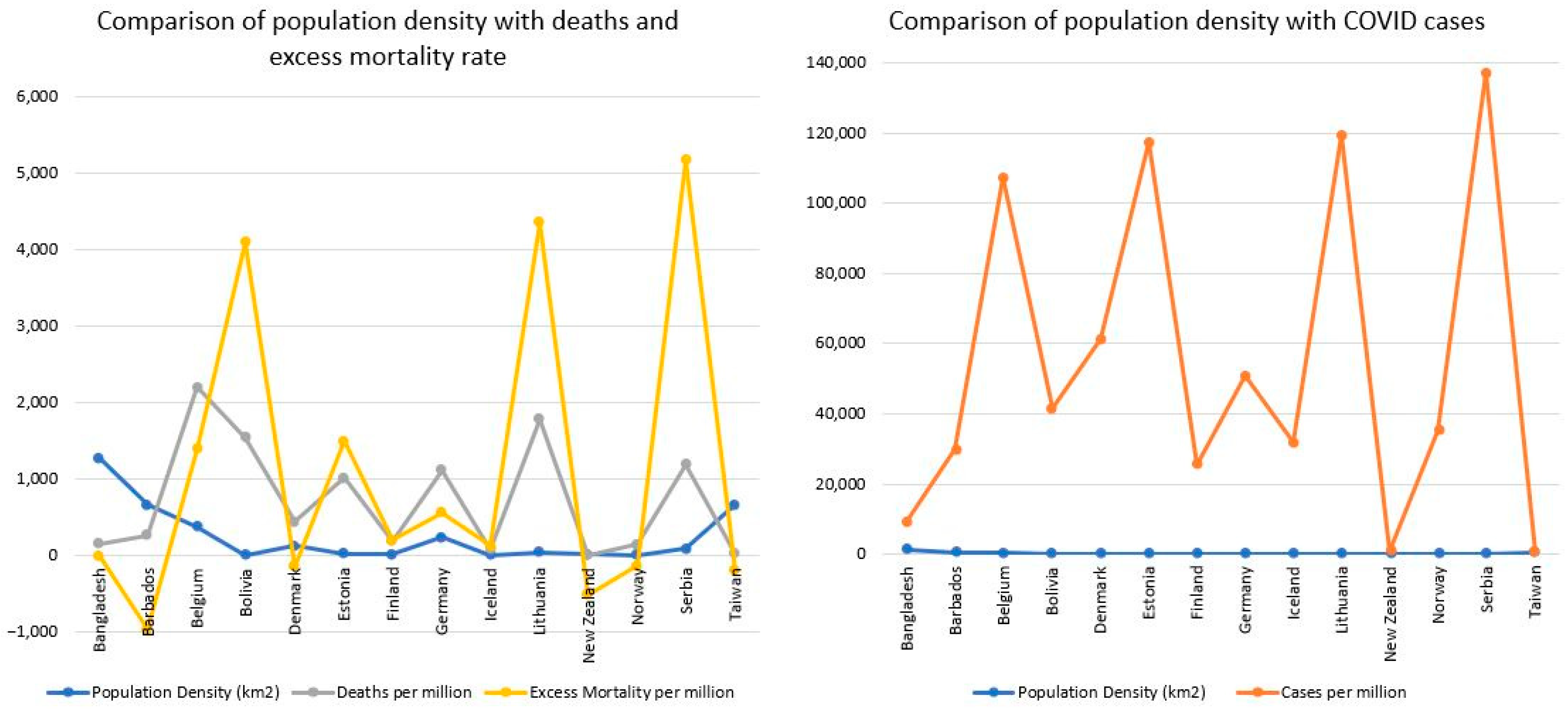
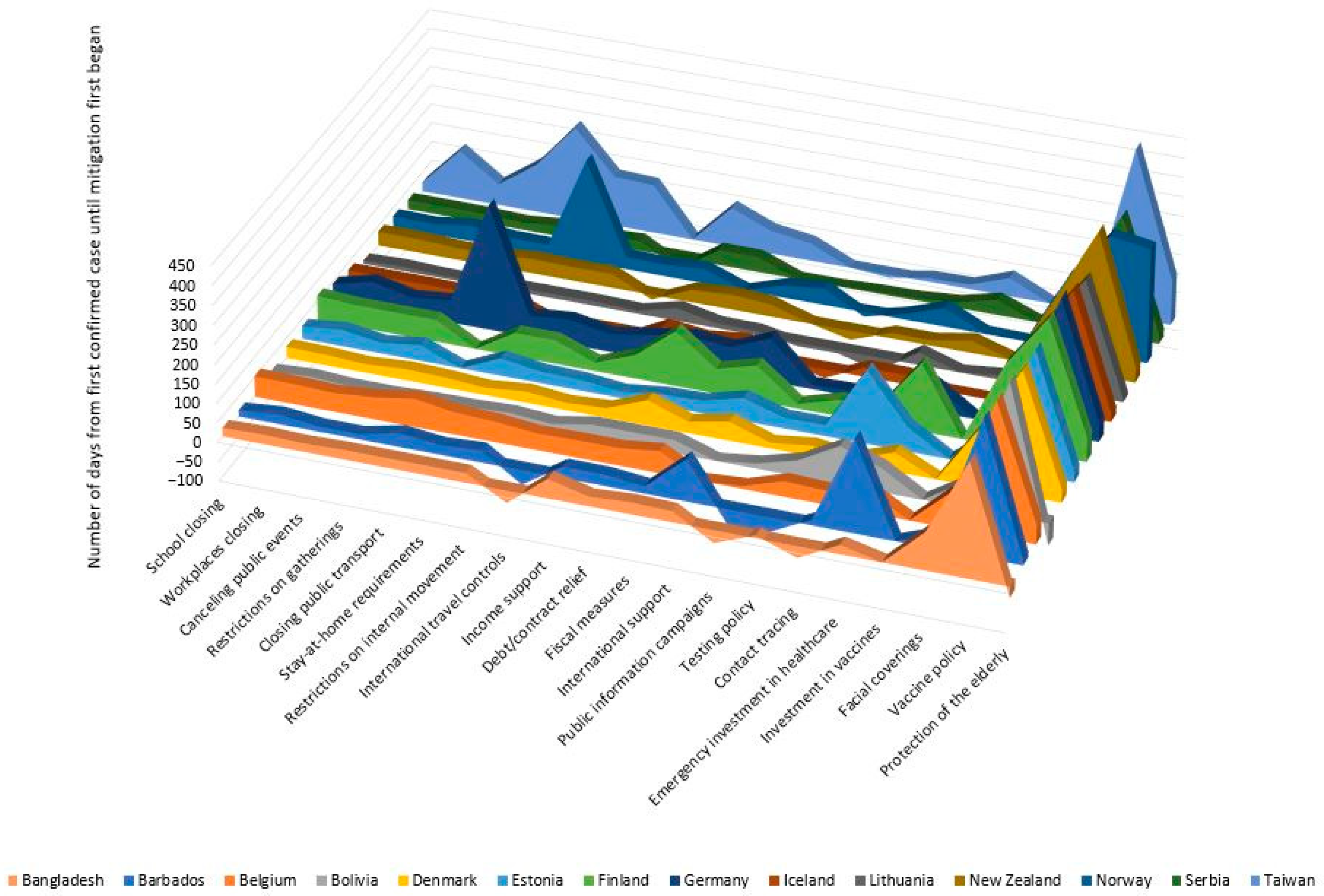
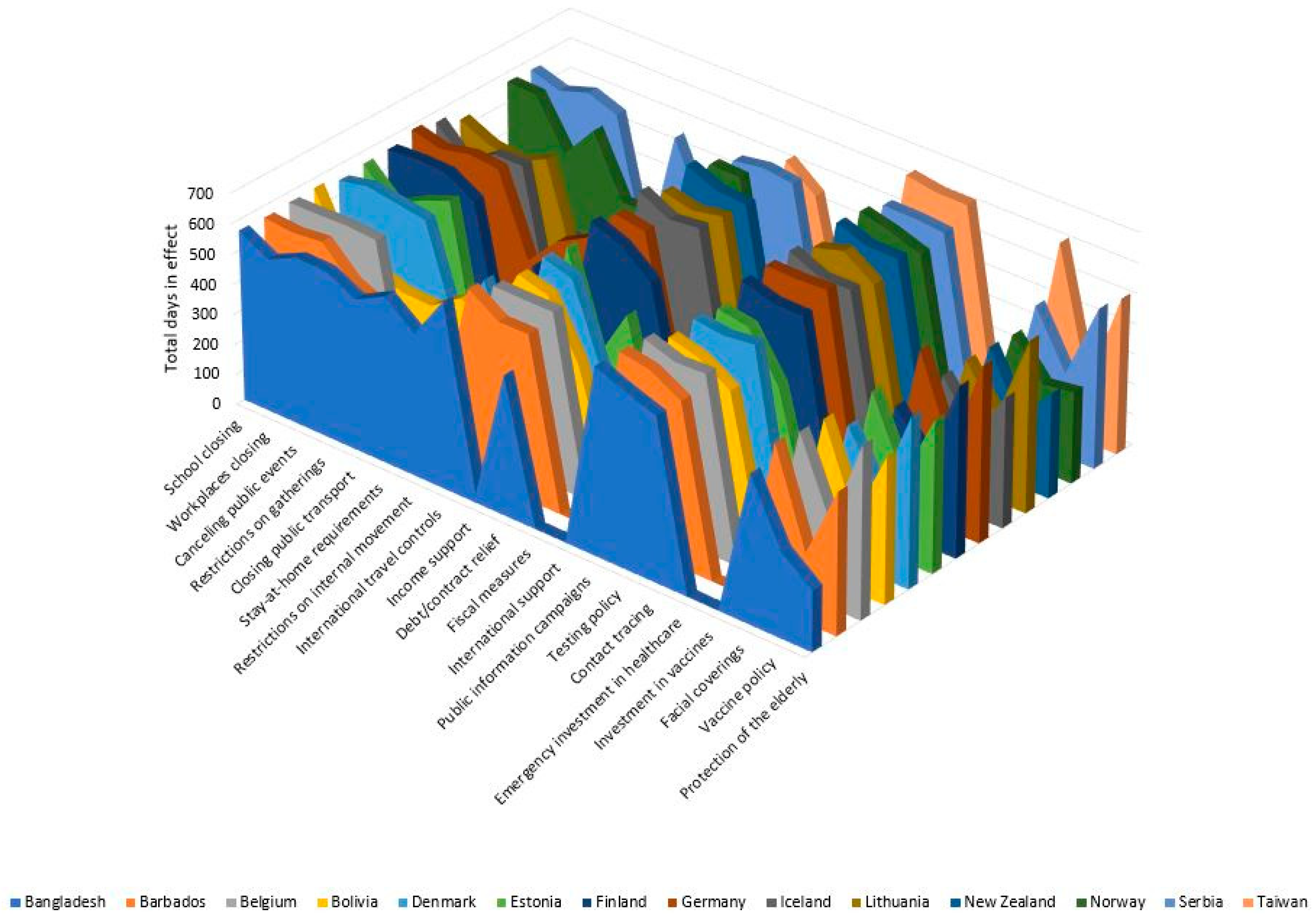
 represents outliers.
represents outliers.
 represents outliers.
represents outliers.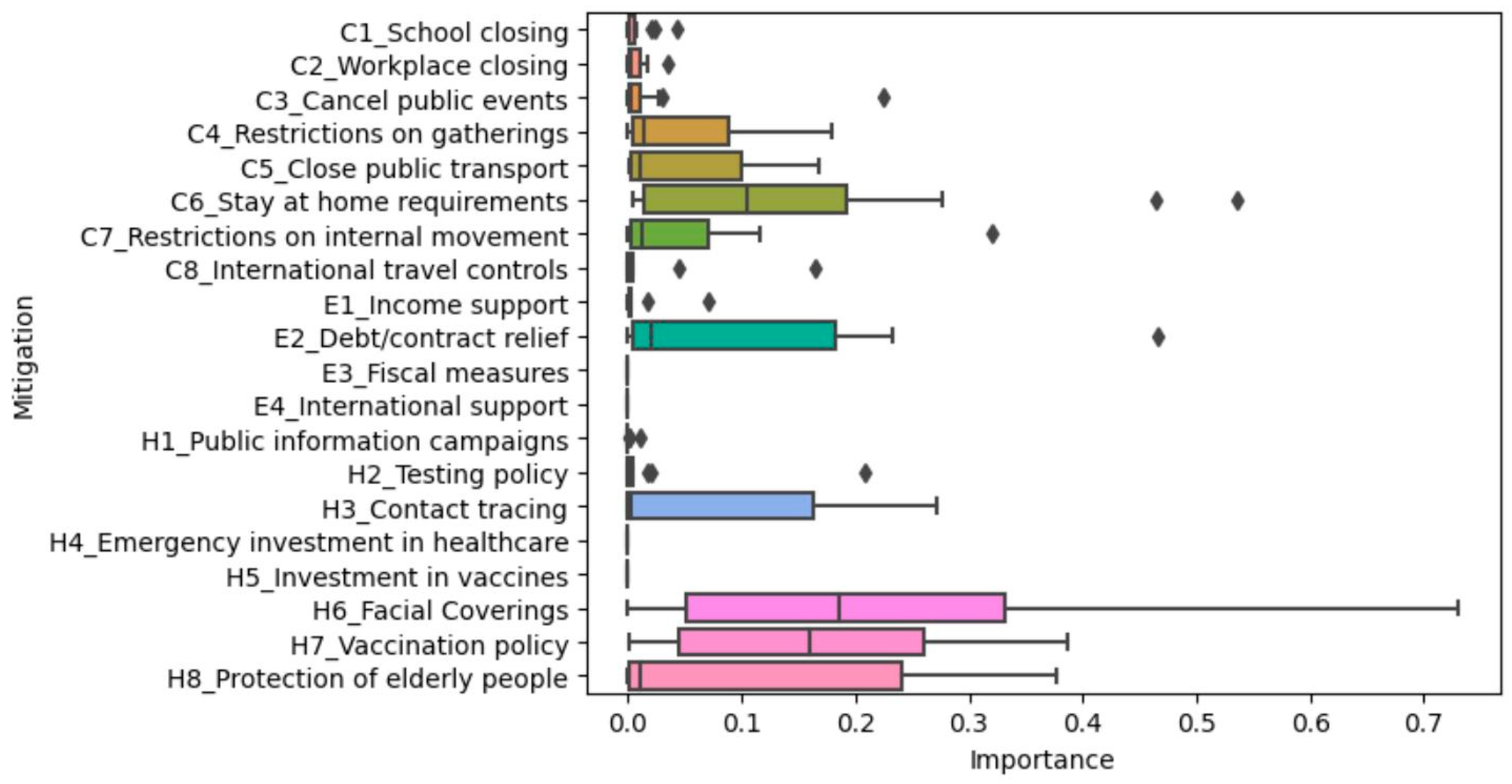
 represents outliers.
represents outliers.
 represents outliers.
represents outliers.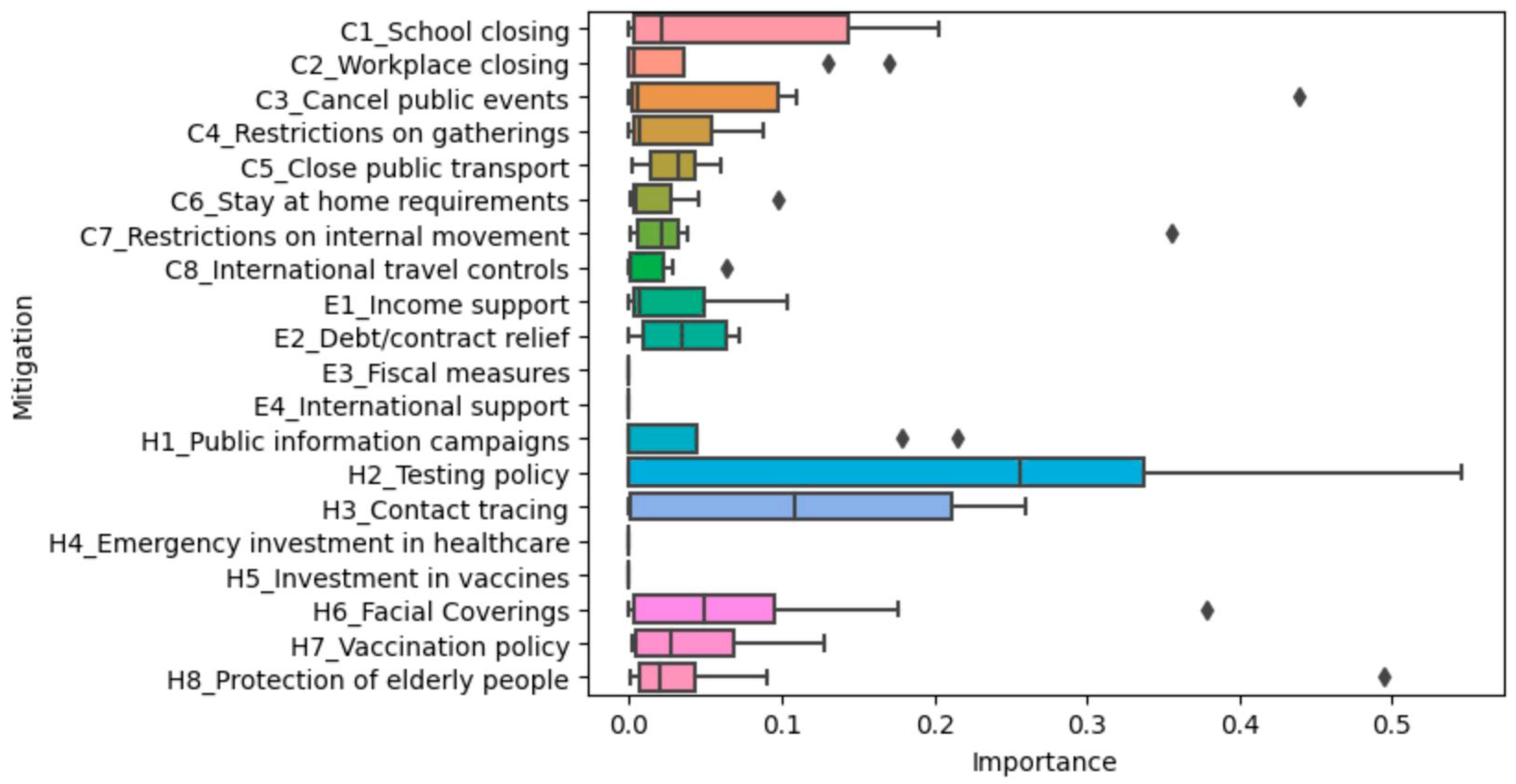
 represents outliers.
represents outliers.
 represents outliers.
represents outliers.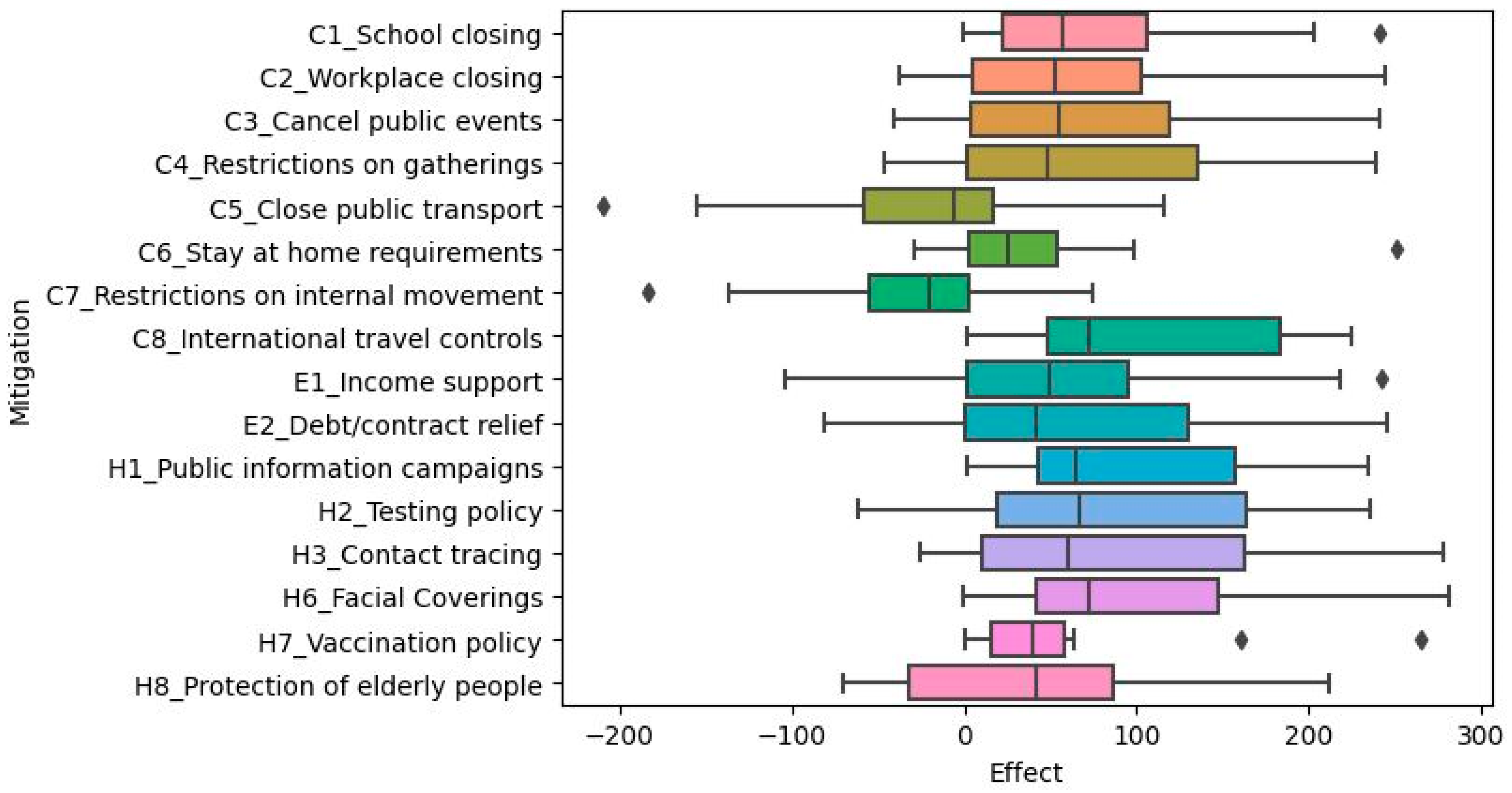
 represents outliers.
represents outliers.
 represents outliers.
represents outliers.